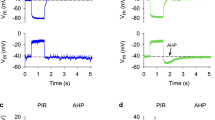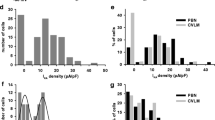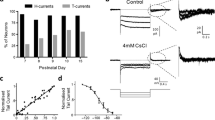Abstract
Previous work has shown that motoneurone excitability is enhanced by a hyperpolarization of the membrane potential at which an action potential is initiated (V th) at the onset, and throughout brainstem-evoked fictive locomotion in the adult decerebrate cat and neonatal rat. Modeling work has suggested the modulation of Na+ conductance as a putative mechanism underlying this state-dependent change in excitability. This study sought to determine whether modulation of voltage-gated sodium channels could induce V th hyperpolarization. Whole-cell patch-clamp recordings were made from antidromically identified lumbar spinal motoneurones in an isolated neonatal rat spinal cord preparation. Recordings were made with and without the bath application of veratridine, a plant alkaloid neurotoxin that acts as a sodium channel modulator. As seen in HEK 293 cells expressing Nav1.2 channels, veratridine-modified channels demonstrated a hyperpolarizing shift in their voltage-dependence of activation and a slowing of inactivation that resulted in an enhanced inward current in response to voltage ramp stimulations. In the native rat motoneurones, veratridine-modified sodium channels induced a hyperpolarization of V th in all 29 neonatal rat motoneurones examined (mean hyperpolarization: −6.6 ± 4.3 mV). V th hyperpolarization was not due to the effects on Ca2+ and/or K+ channels as blockade of these currents did not alter V th. Veratridine also significantly increased the amplitude of persistent inward currents (PICs; mean increase: 72.5 ± 98.5 pA) evoked in response to slow depolarizing current ramps. However, the enhancement of the PIC amplitude had a slower time course than the hyperpolarization of V th, and the PIC onset voltage could be either depolarized or hyperpolarized, suggesting that PIC facilitation did not mediate the V th hyperpolarization. We therefore suggest that central neuronal circuitry in mammals could affect V th in a mechanism similar to that of veratridine, by inducing a negative shift in the activation voltage of sodium channels. Furthermore, this shift appears to be independent of the enhancement of PICs.






Similar content being viewed by others
References
Astman N, Gutnick MJ, Fleidervish IA (1998) Activation of protein kinase C increases neuronal excitability by regulating persistent Na + current in mouse neocortical slices. J Neurophysiol 80:1547–1551
Barnes S, Hille B (1988) Veratridine modifies open sodium channels. J Gen Physiol 91:421–443
Bennett DJ, Hultborn H, Fedirchuk B, Gorassini M (1998) Synaptic activation of plateau potentials in hindlimb motoneurons of decerebrate cats. J Neurophysiol 80:2023–2037
Blanton MG, Lo Turco JJ, Kriegstein AR (1989) Whole cell recording from neurons in slices of reptilian and mammalian cerebral cortex. J Neurosci Methods 30:203–210
Brownstone RM, Jordan LM, Kriellaars DJ, Noga BR, Shefchyk SJ (1992) On the regulation of repetitive firing in lumbar motoneurones during fictive locomotion in the cat. Exp Brain Res 90:441–455
Brownstone RM, Gossard JP, Hultborn H (1994) Voltage-dependent excitation of motoneurones from spinal locomotor centres in the cat. Exp Brain Res 102:34–44
Cantrell AR, Catterall WA (2001) Neuromodulation of Na+ channels: an unexpected form of cellular plasticity. Nat Rev Neurosci 2:397–407
Cantrell AR, Ma JY, Scheuer T, Catterall WA (1996) Muscarinic modulation of sodium current by activation of protein kinase C in rat hippocampal neurons. Neuron 16:1019–1026
Catterall WA, Goldin AL, Waxman SG (2005) International Union of Pharmacology. XLVII. Nomenclature and structure-function relationships of voltage-gated sodium channels (2005). Pharmacol Rev 57:397–409
Dai Y, Jones KE, Fedirchuk B, McCrea DA, Jordan LM (2002) A modeling study of locomotion-induced hyperpolarization of voltage threshold in cat lumbar motoneurones. J Physiol 544:521–536
Dai Y, Jordan LM, Fedirchuk B (2009) Modulation of transient and persistent inward currents by activation of protein kinase C in spinal ventral neurons of the neonatal rat. J Neurophysiol 101:112–128
Fedirchuk B, Dai Y (2004) Monoamines increase the excitability of spinal neurones in the neonatal rat by hyperpolarizing the threshold for action potential production. J Physiol 557:355–361
Felts PA, Yokoyama S, Dib-Hajj S, Black JA, Waxman SG (1997) Sodium channel alpha-subunit mRNAs I, II, III, NaG, Na6 and hNE (PN1): different expression patterns in developing rat nervous system. Brain Res Mol Brain Res 45:71–82
Fox AP, Nowycky MC, Tsien RW (1987) Kinetic and pharmacological properties distinguishing three types of calcium currents in chick sensory neurones. J Physiol 394:149–172
Franceschetti S, Taverna S, Sancini G, Panzica F, Lombardi R, Avanzini G (2000) Protein kinase C-dependent modulation of Na + currents increases the excitability of rat neocortical pyramidal neurones. J Physiol 528(Pt 2):291–304
Gilmore J, Fedirchuk B (2004) The excitability of lumbar motoneurons in the neonatal rat is increased by a hyperpolarization of their voltage threshold for activation by descending serotonergic fibers. J Physiol 558(1):213–224
Grubb MS, Burrone J (2010) Activity-dependent relocation of the axon initial segment fine-tunes neuronal excitability. Nature 465:1070–1074
Harvey PJ, Li Y, Li X, Bennett DJ (2006a) Persistent sodium currents and repetitive firing in motoneurons of the sacrocaudal spinal cord of adult rats. J Neurophysiol 96:1141–1157
Harvey PJ, Li Y, Li X, Bennett DJ (2006b) 5-HT2 receptor activation facilitates a persistent sodium current and repetitive firing in spinal motoneurons of rats with and without chronic spinal cord injury. J Neurophysiol 96:1158–1170
Harvey PJ, Li X, Li Y, Bennett DJ (2006c) Endogenous monoamine receptor activation is essential for enabling persistent sodium currents and repetitive firing in rat spinal motoneurons. J Neurophysiol 96:1171–1186
Jiang Z, Rempel J, Li J, Sawchuk MA, Carlin KP, Brownstone RM (1999) Development of L-type calcium channels and a nifedipine-sensitive motor activity in the postnatal mouse spinal cord. Eur J Neurosci 11:3481–3487
Krawitz S, Fedirchuk B, Dai Y, Jordan LM, McCrea DA (2001) State-dependent hyperpolarization of voltage threshold enhances motoneurone excitability during fictive locomotion in the cat. J Physiol 532:271–281
Kuba H, Oichi Y, Ohmori H (2010) Presynaptic activity regulates Na+ channel distribution at the axon initial segment. Nature 465:1075–1078
Kuo JJ, Lee RH, Zhang L, Heckman CJ (2006) Essential role of the persistent sodium current in spike initiation during slowly rising inputs. J Physiol 574(Pt 3):819–834
Lee RH, Heckman CJ (2001) Essential role of a fast persistent inward current in action potential initiation and control of rhythmic firing. J Neurophysiol 85:472–475
Leibowitz MD, Sutro JB, Hille B (1986) Voltage-dependent gating of veratridine-modified Na channels. J Gen Physiol 87:25–46
Li Y, Bennett DJ (2003) Persistent sodium and calcium currents cause plateau potentials in motoneurons of chronic spinal rats. J Neuophysiol 90:857–869
Li Y, Gorassini MA, Bennett DJ (2004) Role of persistent sodium and calcium currents in motoneurone firing and spasticity in chronic spinal rats. J Neurophysiol 91:767–783
Ostman JA, Nassar MA, Wood JN, Baker MD (2008) GTP up-regulated persistent Na + current and enhanced nociceptor excitability require NaV1.9. J Physiol 586:1077–1087
Power KE, McCrea DA, Fedirchuk B (2010) Intraspinally mediated state-dependent enhancement of motoneurone excitability during fictive scratch in the adult decerebrate cat. J Physiol 588:2839–2857
Rekling JC, Funk GD, Bayliss DA, Dong XW, Feldman JL (2000) Synaptic control of motoneuronal excitability. Physiol Rev 80:767–852
Schmidt BJ (1994) Afterhyperpolarization modulation in lumbar motoneurons during locomotor-like rhythmic activity in the neonatal rat spinal cord in vitro. Exp Brain Res 99:214–222
Schwindt PC, Crill WE (1982) Properties of a persistent inward current in normal and TEA-injected motoneurons. J Neurophysiol 43:1700–1724
Sherrington CS (1906) The integrative action of the nervous system, 1947 edition. Cambridge University Press
Sutro JB (1986) Kinetics of veratridine action on Na channels of skeletal muscle. J Gen Physiol 87:1–24
Tazerart S, Vinay L, Brocard F (2008) The persistent sodium current generates pacemaker activities in the central pattern generator for locomotion and regulates the locomotor rhythm. J Neurosci 28:8577–8589
Acknowledgments
The authors would like to thank Carolyn Gibbs, Maria Setterbom, and Matt Ellis for technical assistance. This work was supported by an operating grant to B.F. from Canadian Institutes of Health Research and by studentships to KEP from the Natural Sciences and Engineering Research Council, Manitoba Health Research Council and the Health Sciences Centre Foundation.
Author information
Authors and Affiliations
Corresponding author
Rights and permissions
About this article
Cite this article
Power, K.E., Carlin, K.P. & Fedirchuk, B. Modulation of voltage-gated sodium channels hyperpolarizes the voltage threshold for activation in spinal motoneurones. Exp Brain Res 217, 311–322 (2012). https://doi.org/10.1007/s00221-011-2994-3
Received:
Accepted:
Published:
Issue Date:
DOI: https://doi.org/10.1007/s00221-011-2994-3




